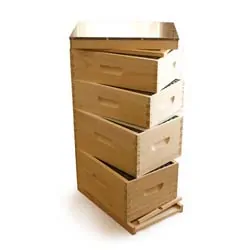April is the cruellest month, breeding
Lilacs out of dead land, mixing
Memory and desire, stirring
Dull roots with the spring rain
– T.S. Eliot The Waste Land
Introduction
In April, mentally, it’s easy to have the mindset that the bees got through the winter. You think you can breathe a sigh of relief and relax, but it’s actually too soon to stop being vigilant. If anything, April requires more vigilance. In the winter, once the hive is prepped, there’s nothing else you, as the beekeeper, can do. In April, the fluctuating temperatures and lack of food mean even the most non-invasive beekeeper will need to monitor the hive and supply food.
Feeding
Feeding in the spring is a bit simpler than feeding in the winter. The bees are moving around and more able to control the inner environment of the hive. A 1:1 ration of sugar to water (boiled and stirred until the sugar dissolves) is recommended for spring feeding until there is enough naturally growing forage plants. The 1:1 ratio also helps stimulate hive growth, which strengthens the hive to protect against absconding or robbing.
Depending on where you live, you may need to feed through May. The best way to know when it’s safe to stop feeding is to observe the plants. What’s in bloom? How much of what’s growing provides bee food? Observing and thinking along these lines will help you ensure your bees are fed when needed, but don’t become dependent upon syrup.
Monitoring
Weekly hive checks are a good idea all year long, but particularly in the spring. Extra care needs to be taken in these first weeks, however. Since the weather is so volatile, it’s important to be sure you’re not opening the hive on a cold/rainy day. I basically become an amateur weather forecaster during April and watch the forecast with intensity.
If it’s going to reach 50°F or higher without precipitation, it might be a good day to plan to check the hive. Wait until the high as been reached before opening the hive. Also, if you’re using an inner-hive feeder, plan to refill it at the same time as your hive inspection to avoid opening it multiple times.
Summary
April is a time to celebrate the end of winter, but it’s also a time to use extra care and caution in the bee yard. Getting overly excited and inattentive can lead to the loss of your precious bees just when you thought you’d successfully gotten them through the winter. Hive check and appropriate feeding are keys to getting bees through April, the cruelest month for bees, beekeepers, and T.S. Eliot.

